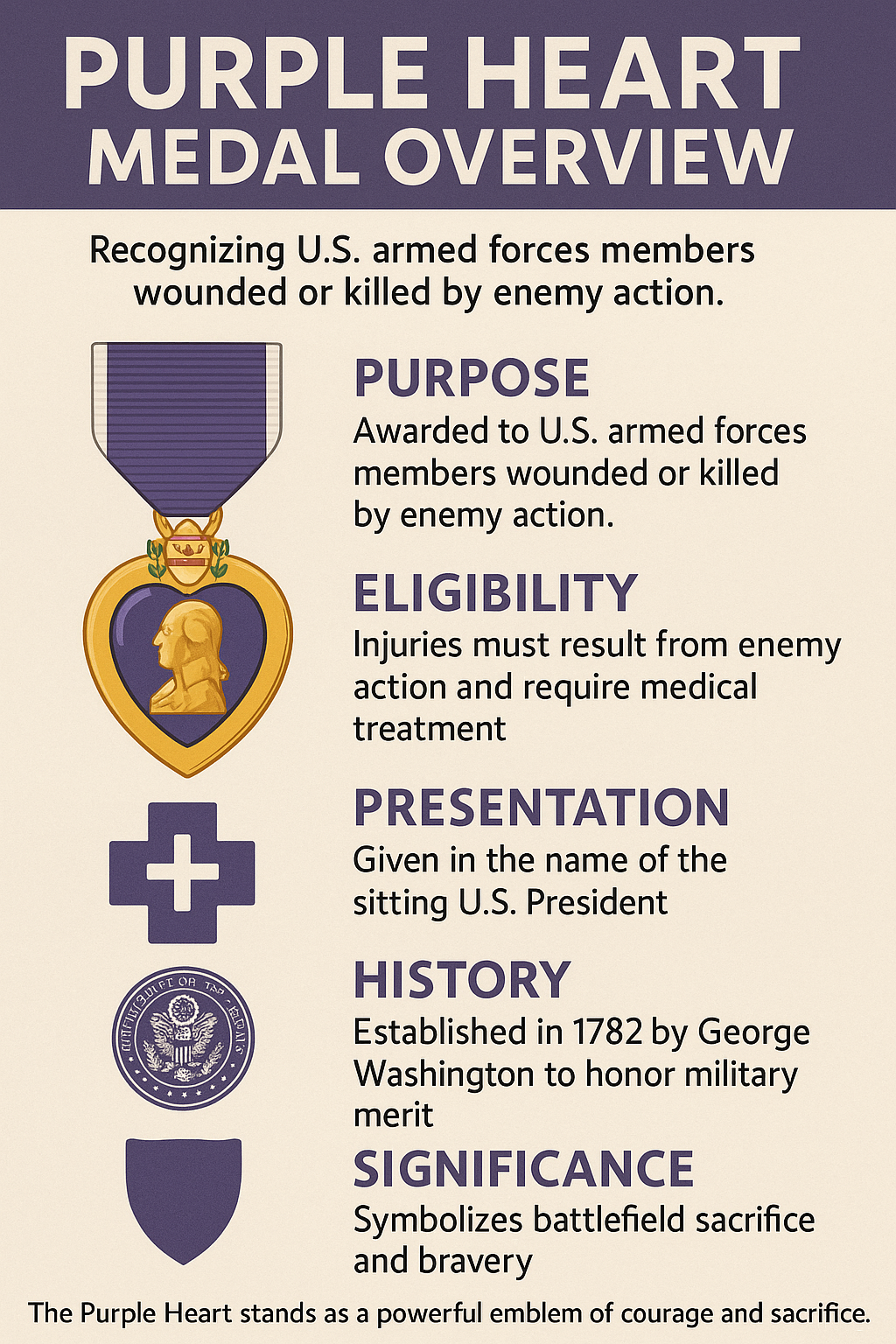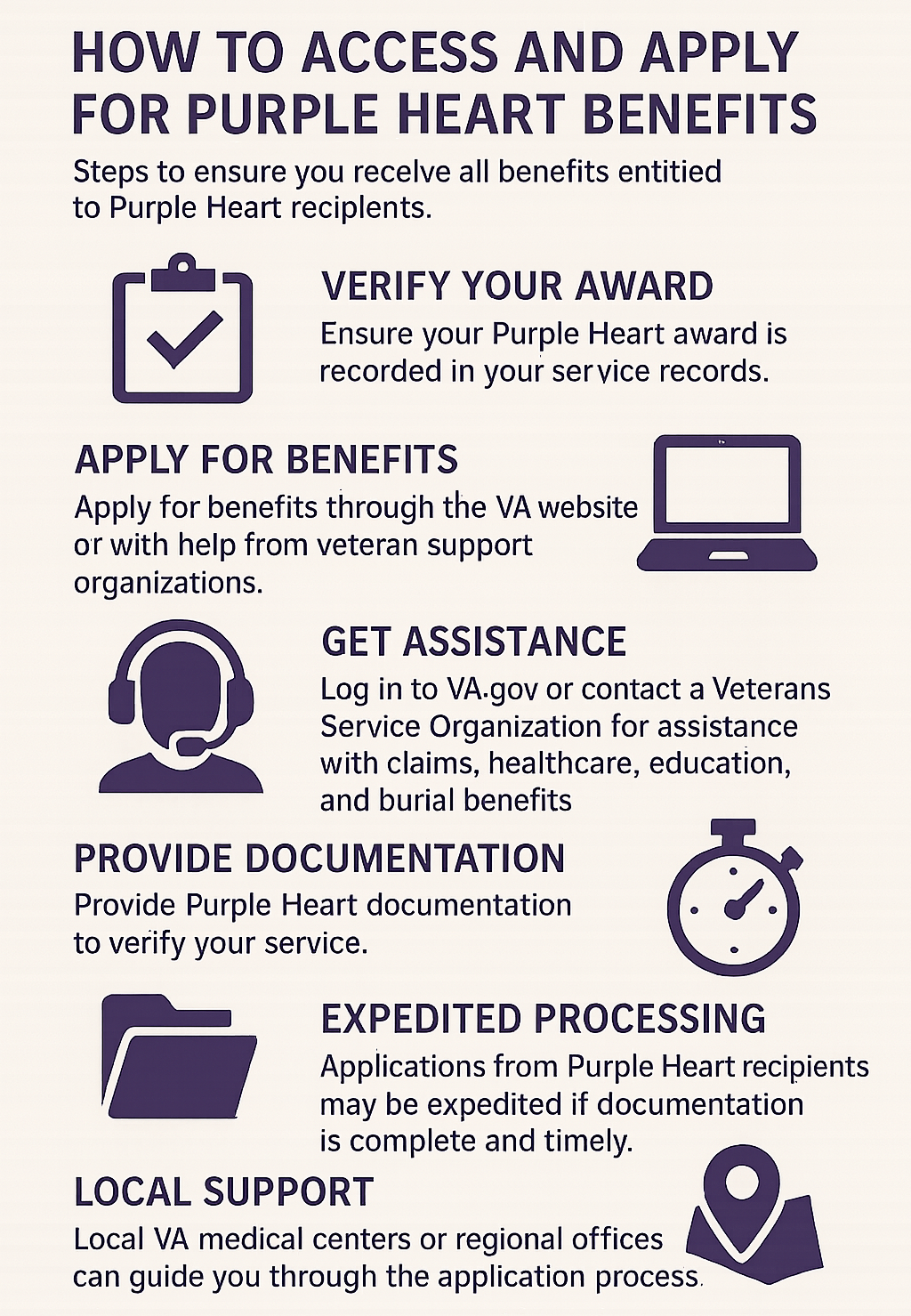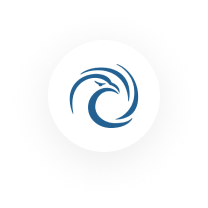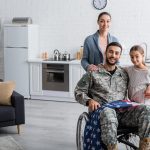A Purple Heart is one of the most distinguished honors that a United States service member can receive. Its origins trace back to the Badge of Military Merit, established by George Washington to recognize military merit and valor. It symbolizes extraordinary sacrifice in the line of duty and is often presented to brave men who were wounded or killed in action while serving their country. The Purple Heart recognizes incredible courage under fire, as well as the lasting impact of service on a veteran’s life, and stands as a symbol of honor and the nation’s gratitude for their sacrifice.
Beyond the emotional significance of receiving this medal, the Purple Heart Medal is a prestigious military award that brings both symbolic and practical benefits, including priority medical care and federal employment preference. The Department of Veterans Affairs (VA) also provides a number of valuable benefits to recipients. These additional benefits can make a difference in their healthcare, education, financial stability, and even end-of-life recognition. All of these resources are designed to support the physical and emotional recovery veterans may need. That said, knowing the full scope of available benefits is the first step in claiming the support you’ve rightfully earned.
What Is the Purple Heart Medal and Who Receives It?

As explained above, the Purple Heart is a combat medal awarded to members of the armed forces who have been wounded or killed by enemy action. The wounds received must be the result of enemy action and require medical treatment to qualify for the award. It is given in the name of the sitting President of the U.S. The medal was first established by George Washington in 1782 to recognize military merit. Over the years, it has become a powerful symbol of battlefield sacrifice.
Overview of VA Benefits for Purple Heart Recipients
These benefits from Veterans Affairs span several categories, offering recipients tangible support in their civilian lives. These benefits include:
- VA Health care benefits
- Education benefits
- Financial compensation
- Specific burial honors
- Compensation benefits
- Home loan guaranty
In addition to federal benefits, many states offer additional state benefits for Purple Heart recipients, such as tuition waivers, special license plates, and other forms of support. Some programs help cover fees and provide coverage for educational and healthcare expenses for recipients and their family members. Organizations, including government agencies and veteran support groups, play a key role in delivering these benefits.
Health Care Priority and Access for Purple Heart Veterans

The VA prioritizes the needs of service members who have received this award. Purple Heart recipients are eligible for enhanced health care benefits, including priority access to medical treatment and comprehensive coverage. They may be exempt from paying certain copays or fees for VA health care benefits. The VA also provides assistance to help veterans with disabilities navigate the healthcare system and access their entitled benefits. Specifically, recipients are placed in Priority Group 3—a higher tier that offers access to care before lower-priority groups and typically requires fewer copayments. They also get priority in treatment queues, claim processing, and support services. While many of the benefits align with those offered to all service-connected veterans, recipients of the Purple Heart often receive access sooner or under fewer eligibility constraints.
Veterans in this group are eligible for full access to primary care, specialty care, mental health services, prescriptions, and prosthetics. The VA also waives many income thresholds and means-testing requirements for Purple Heart recipients, which helps ensure care is delivered promptly and affordably. This recognition goes beyond honoring the service members. It also has a direct impact on care outcomes, reducing wait times and allowing them to receive more proactive management of injuries related to combat.
Disability Compensation and the Purple Heart
While you will be eligible for certain benefits immediately, a Purple Heart isn’t an automatic disability rating. That said, many recipients do wind up receiving VA disability compensation due to the injuries and wounds received from combat. As with other veterans, compensation is based on the severity of the injury, disabilities, or illness and how it impacts your everyday function. Veterans can submit lay statements to support their claims, especially when the wounds received are related to combat. Disabilities and illnesses linked to service can qualify for compensation, and monthly payments are a key part of VA disability compensation. An evaluation is needed. However, having a combat medal like the Purple Heart can streamline the process of establishing service connection. Purple Heart veterans typically have an easier time proving a service connection to their injuries.
Education and GI Bill Enhancements for Purple Heart Recipients
Education benefits are something that many Purple Heart recipients take advantage of. These benefits were expanded under the Forever GI Bill. Starting August 1, 2018, veterans who earned a Purple Heart on or after September 11, 2001, and served at least 30 continuous days on active duty are granted 100% of the Post-9/11 GI Bill benefits. This provides them with the following:
- Full tuition at public institutions
- A housing allowance
- Book stipends
Certain programs, such as the Yellow Ribbon Program, help cover fees and pay for tuition and related educational expenses that go beyond what the GI Bill alone provides. Completing active duty training is essential to qualify for these education benefits and programs.
Purple Heart recipients may also be eligible for exemptions from the VA funding fee when applying for a VA guaranteed home loan, which can reduce the overall cost of homeownership. In addition, recipients and their family members may be eligible for commissary and exchange privileges, allowing them to shop at military commissaries and exchanges.
This can help Purple Heart recipients re-enter the workforce through education or retraining. Not to mention, these benefits can be transferred to eligible dependents if they meet certain service conditions.
Burial and Memorial Honors for Purple Heart Veterans
Purple Heart recipients are eligible for enhanced burial benefits through the VA and the Department of Defense. This includes interment in a national cemetery, a government-furnished headstone or marker, a burial flag, and a Presidential Memorial Certificate.
In some cases, burial benefits for Purple Heart recipients may include coverage for funeral expenses, providing important support to loved ones. Eligibility for these benefits is generally extended to include surviving spouses and minor dependents. The VA offers assistance to families in navigating the application process for these honors, ensuring that loved ones receive the support and recognition they deserve.
Families can also request military funeral honors, which include a ceremonial flag folding, presentation, and the playing of Taps. These gestures are powerful reminders of a nation’s gratitude, and they carry particular weight for those who bore the cost of combat firsthand.
How to Access and Apply for Purple Heart Benefits

To access VA Purple Heart benefits, the first step is ensuring the Purple Heart award is recorded in the veteran’s service records. Most benefits are not automatically granted—you must apply for them through the appropriate VA channels. Veterans should submit their claims and documentation through the VA website or with the help of organizations that support veterans. These organizations can provide valuable assistance throughout the application process.
Start by logging in to your VA.gov account, or contact a Veterans Service Organization that can help file claims, healthcare enrollment forms, and education benefit applications. When applying for healthcare, disability compensation, or burial benefits, be sure to provide your Purple Heart documentation as part of your service verification.
In many cases, Purple Heart recipients can have their applications expedited or prioritized, but the key is timely, complete documentation. If you’re unsure where to begin, a local VA medical center or regional office can walk you through the steps.
FAQs About Purple Heart Benefits
Here are some of the most frequently asked questions about Purple Heart benefits.
- Is a Purple Heart recipient automatically eligible for VA benefits? No. While the Purple Heart strengthens eligibility for many benefits, veterans still need to apply through VA channels and provide documentation of their award and service.
- What priority group is a Purple Heart recipient in for VA healthcare? Purple Heart recipients are placed in Priority Group 3, which grants higher access to VA medical services and often waives copayments.
- Does the Purple Heart automatically grant a VA disability rating? No. The Purple Heart supports the claim, but disability ratings are based on medical evidence and how injuries affect daily life.
- Are Purple Heart recipients guaranteed free college tuition? If awarded after September 11, 2001, and the veteran served at least 30 continuous days, recipients are eligible for 100% of Post-9/11 GI Bill benefits.
- Are there specific programs that help Purple Heart recipients with education costs? Yes. Programs such as the Yellow Ribbon Program can provide additional support to cover tuition and fees at private or out-of-state schools that exceed the standard Post-9/11 GI Bill coverage.
- What state benefits are available to Purple Heart recipients? Many states offer additional state benefits, such as property tax exemptions, tuition waivers, special license plates, and discounts on services, to honor and support Purple Heart recipients.
- Do Purple Heart recipients receive federal hiring preferences? Yes. Purple Heart recipients are eligible for federal hiring preferences, giving them an advantage in the federal employment process and access to certain veteran hiring initiatives.
- What types of coverage are available to family members of Purple Heart recipients? Family members may be eligible for healthcare coverage, educational assistance, and other VA benefits, depending on the veteran’s service and eligibility status.
- Can the family of a deceased Purple Heart veteran receive burial benefits? Yes. Surviving spouses and minor dependents may qualify for burial allowances, national cemetery interment, and memorial honors.
These Benefits Were Earned—Don’t Miss Out
The Purple Heart is more than a medal. It’s a symbol of sacrifice, resilience, and service—and it comes with meaningful recognition through VA programs. From healthcare access to full education benefits and burial honors, Purple Heart veterans have earned a level of support that can change their post-service lives. But these benefits are not automatic. You have to claim them, ask questions, and push forward.
If you or a loved one is a Purple Heart recipient, take the time to explore what’s available. See how AllVeteran.com can help you.
 AllVeteran.com Advisors
AllVeteran.com Advisors
With expertise spanning local, state, and federal benefit programs, our team is dedicated to guiding individuals towards the perfect program tailored to their unique circumstances.


















